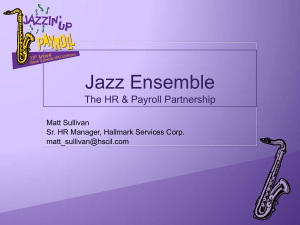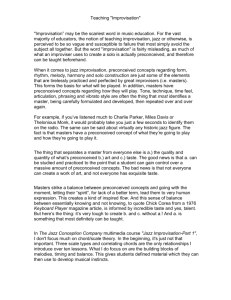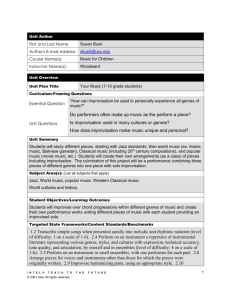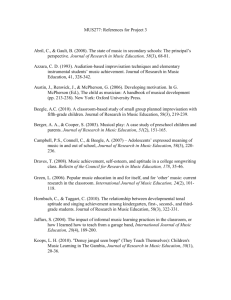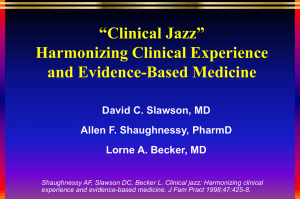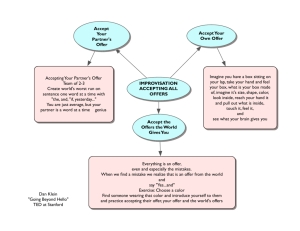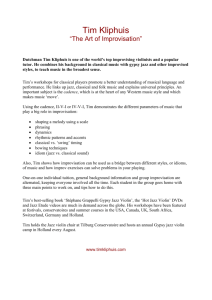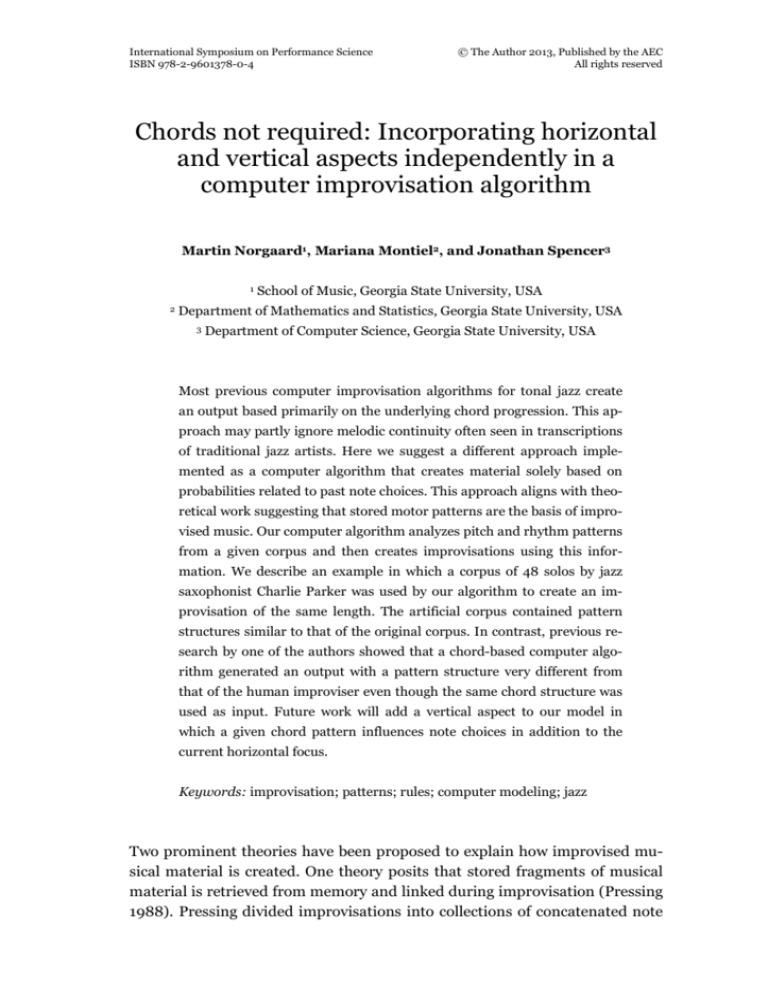
International Symposium on Performance Science
ISBN 978-2-9601378-0-4
© The Author 2013, Published by the AEC
All rights reserved
Chords not required: Incorporating horizontal
and vertical aspects independently in a
computer improvisation algorithm
Martin Norgaard1, Mariana Montiel2, and Jonathan Spencer3
1
2
School of Music, Georgia State University, USA
Department of Mathematics and Statistics, Georgia State University, USA
3
Department of Computer Science, Georgia State University, USA
Most previous computer improvisation algorithms for tonal jazz create
an output based primarily on the underlying chord progression. This approach may partly ignore melodic continuity often seen in transcriptions
of traditional jazz artists. Here we suggest a different approach implemented as a computer algorithm that creates material solely based on
probabilities related to past note choices. This approach aligns with theoretical work suggesting that stored motor patterns are the basis of improvised music. Our computer algorithm analyzes pitch and rhythm patterns
from a given corpus and then creates improvisations using this information. We describe an example in which a corpus of 48 solos by jazz
saxophonist Charlie Parker was used by our algorithm to create an improvisation of the same length. The artificial corpus contained pattern
structures similar to that of the original corpus. In contrast, previous research by one of the authors showed that a chord-based computer algorithm generated an output with a pattern structure very different from
that of the human improviser even though the same chord structure was
used as input. Future work will add a vertical aspect to our model in
which a given chord pattern influences note choices in addition to the
current horizontal focus.
Keywords: improvisation; patterns; rules; computer modeling; jazz
Two prominent theories have been proposed to explain how improvised musical material is created. One theory posits that stored fragments of musical
material is retrieved from memory and linked during improvisation (Pressing
1988). Pressing divided improvisations into collections of concatenated note
726
WWW.PERFORMANCESCIENCE.ORG
groupings. Each grouping is triggered by a creative intention in the form of a
mental schema that contains a cognitive image of sound and corresponding
motor realization. His theory implies that these mental schemas are retrieved
from a stored library. Therefore, if his theory is accurate, improvisations by
artist-level improvisers should contain repeated melodic and rhythmic figures
as the improviser repeatedly accesses the same mental schema from this library.
A competing theory emphasizes the role of tonal rules and how these rules
may guide the improvising performer without storing and reusing material
(Johnson-Laird 2002). According to this view, improvisations may still contain repeated melodic figures but they appear by chance due to the guiding
tonal rules or are temporarily stored to be used again only within the same
improvisation. Johnson-Laird wrote a computer program that can create jazz
bass lines from a given chord progression using rules in support of his theory.
Similarly, the computer program Impro-Visor uses rules to create monophonic jazz improvisations based on a given chord progression (Gillick et al.
2010). One problem with this approach is its dependence on a given chordal
framework.
A previous study by one of the authors explored the use of patterns in tonal jazz by analyzing a large corpus of improvisations by the jazz saxophonist
Charlie Parker (Norgaard in press). The study showed extensive use of patterns lending support to Pressing’s theory that improvisers develop a stored
library of patterns serving as the basis for new improvisations. In that study,
interval and rhythm patterns were investigated starting on each note position.
Results showed that 82.6% of all notes in the corpus began a four-interval
pattern and 57.6% began interval and rhythm patterns. Furthermore, patterns up to 49-intervals were identified. Importantly, many of the longer interval patterns were distributed over several improvisations recorded at different times. Specifically, of the 98 identified unique patterns of 15-intervals
or longer, 61% occurred in different solos suggesting that these patterns were
not temporarily stored during the current improvisation as suggested by
Johnson-Laird (2002).
Improvisations containing a large number of repeated patterns may appear more structurally sound as listeners focus on the melodic line. Artistlevel jazz improvisers weigh both melodic (horizontal) and chordal (vertical)
considerations during improvisation (Berliner 1994, Norgaard 2011). Improvisers may follow the logic of the horizontal line to create material that may or
may not fit the actual chords. In a previous qualitative study, one participant
described a phrase as having “no map behind that part” referring to the lack
of attention to the underlying harmonic “map” (Norgaard 2011, p. 120).
INTERNATIONAL SYMPOSIUM ON PERFORMANCE SCIENCE
727
The current project further explores the possibility that improvisations
are based on a library of patterns through the implementation of a computer
algorithm for improvisation based on this principle. We compare the output
from our algorithm both with the results from the Parker study but also with
results of a competing computer algorithm. This algorithm uses a rule-based
approach where the output is dictated by the underlying chord progression.
The majority of previous computer models of improvisation are based on
strict relationships between the improvised line and the underlying chords
(Gillick et al. 2010, Johnson-Laird 2002, Rolland and Ganascia 2000). In two
of these models, grammars based directly on the underlying chord progression are used to create improvised material, thereby overemphasizing vertical
elements in improvisational thinking (Johnson-Laird 2002, Keller and
Morrison 2007). To counter this bias, the current computer model emphasizes the horizontal aspect exclusively. In future work, we plan to further develop our model to take a given chordal structure into consideration. Our
final goal is to create software for improvisation in which both horizontal and
vertical aspects interact in a manner that more accurately reflects the thinking of artist-level jazz improvisers.
MAIN CONTRIBUTION
In the previous study, transcriptions of 48 improvisations by Charlie Parker
were included in the corpus for analysis (Norgaard in press). The master
MIDI file was imported into the Matlab computer environment using a modified version of the Midi Toolbox for Matlab (“Matlab” 2011, Smit n.d.). Then,
for example, the use of five-note patterns was investigated by searching for
fourinterval patterns with an algorithm within Matlab that, starting with the
first four intervals (e.g. +2, +2, +1, -1), looked for additional occurrences of
this interval sequence in the corpus. The result represented the number of
times the interval pattern +2, +2, +1, -1 occurred in the corpus and the number of times the pattern starting on this note position reappeared in the corpus. The program then went on to the interval pattern starting on the following note and looked for the number of occurrences of this pattern. Using this
procedure, the number of patterns occurring on each note position was reported. A similar procedure using beat onset times was used to investigate
rhythm patterns.
Building on this previous work we decided to find a way to concatenate
pitch patterns to generate improvisations based on transitional probabilities
within a given corpus. The first step was to create a model for the melody
(intervals). In the algorithm, a change in pattern was determined by deleting
728
WWW.PERFORMANCESCIENCE.ORG
the first interval of the previous pattern and adding a new interval. For example, a 4-interval pattern, [2212], might be followed by [2121], with the result
that the concatenated interval sequence would be [22121]. Indeed, in this
case, the following pattern was contingent upon the last 3 intervals of the
preceding pattern.
Results
The initial version of the algorithm only incorporated pitches (see Figure 1).
The examples provided are all improvisations based on the probabilities extracted from the Parker corpus mentioned above.
After evaluating the result of the melody algorithm for the concatenation
of the patterns, we decided to continue in the same vein for the treatment of
rhythm. To keep these techniques as similar as possible, rhythmic patterns
were also decided to span 5 notes. A rhythmic pattern is a combination of four
contiguous note durations and the time from each of these note onsets to the
next. We tested this approach by superimposing separately-generated rhythm
and pitch improvisations into the same improvisation. This melody/rhythm
algorithm created improvisations in which both pitch and rhythm patterns
were present but where no relationship existed between the two parameters
(see Figure 2).
In the music created by a human improviser, typically there is a relationship between pitch and rhythm patterns. For example, Charlie Parker often
plays arpeggiated chords using a triplet rhythm. Therefore the final implementation of our algorithm takes this relationship into account. In the latest
working version of our algorithm, rhythm and interval patterns are played
concurrently only when they coincide at some point in the imported corpus
(see Figure 3).
IMPLICATIONS
The strength of this approach is evident in that a given chord pattern is not
necessary for the algorithm to create new material. It is well known that jazz
musicians can improvise without a given chord structure by solely focusing
on horizontal considerations. In other words, the underlying chord progression used in tonal jazz is only partly responsible for the creation of melodic
material. We believe this is the first time computational modeling of musical
tonal improvisation has independently applied vertical and horizontal aspects
in the model. In future developments of our algorithm we aim to incorporate
underlying chord structures in a way that will independently influence note
choices.
INTERNATIONAL SYMPOSIUM ON PERFORMANCE SCIENCE
729
Figure 1. Example of an improvisation created with the pitch-only algorithm.
Figure 2. Example of an improvisation created with the independent pitch and rhythm
algorithm.
Figure 3. Example of an improvisation created with the most current algorithm in
which pitches and rhythms are related.
Our model appears to support the viability of Pressing’s (1988) theory in
which stored fragments are reused during improvisation. It also aligns with
existing motor learning research outlining how general motor programs are
acquired and later reused (e.g. Shea and Wulf 2005). Language acquisition
theories that emphasize statistical processes for pattern learning also may
share features with the described computer model for musical improvisation
(e.g. Saffran 2003). The current model may therefore illuminate domain
general mechanisms related to pattern-based generative and learning
processes.
Address for correspondence
Martin Norgaard, School of Music, Georgia State University, PO Box 4097, Atlanta,
Georgia 30302, USA; Email: mnorgaard@gsu.edu
730
WWW.PERFORMANCESCIENCE.ORG
References
Berliner P. F. (1994). Thinking in Jazz. Chicago: University Of Chicago Press.
Gillick J., Keller R. M., and Tang K. (2010). Machine learning of jazz grammars.
Computer Music Journal, 34, pp. 56-66.
Johnson-Laird P. N. (2002). How jazz musicians improvise. Music Perception, 19, pp.
415-442.
Keller R. and Morrison D. (2007). A grammatical approach to automatic improvisation.
Proceedings of the 4th Sound and Music Computing Conference (pp. 330-337).
Matlab (2011). Mathworks, Inc.
Norgaard M. (2011). Descriptions of improvisational thinking by artist-level jazz
musicians. Journal of Research in Music Education, 59, pp. 109-127.
Norgaard M. (in press). How jazz musicians improvise: The central role of auditory and
motor patterns. Music Perception.
Pressing J. (1988). Improvisation: Methods and model. In J. A. Sloboda (ed.),
Generative Processes in Music (paperback, pp. 129-178). Oxford: Oxford University
Press.
Rolland P. -Y. and Ganascia J. -G. (2000). Musical pattern extraction and similarity
assessment. In E. R. Miranda (ed.), Readings in Music and Artificial Intellegence
(pp. 115-144). Amsterdam: Harwood Academic Publishers.
Saffran J. R. (2003). Statistical language learning: Mechanisms and constraints. Current Directions in Psychological Science, 12, pp. 110-115.
Shea C. H. and Wulf G. (2005). Schema theory : A critical appraisal and reevaluation.
Journal of Motor Behavior, 37, pp. 85-101.
Smit C. (n.d.). Midi Tools: Extending the Midi Toolbox in Matlab, accessed at: http://
www.ee.columbia.edu/~csmit/matlab_midi.html.

